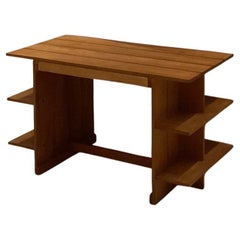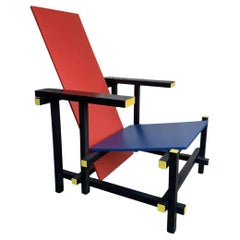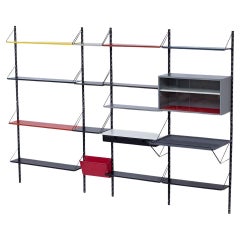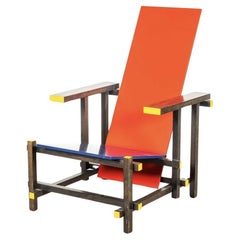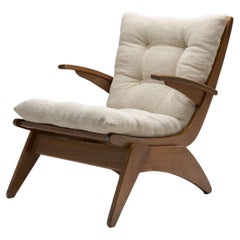De Stijl Furniture
It has been more than 100 years since the founding of the Dutch art and design movement known as De Stijl.
It was in October of 1917 that artist, architect and critic Theo van Doesburg released the first issue of De Stijl magazine. A platform for artists, designers and architects to express their revolutionary new ideas, the journal was a launching point for what would become an international movement. Meaning “the Style,” De Stijl was an attempt at pure abstraction — one centered on the use of primary colors and perpendicular lines as a utopian expression of a harmonious world.
Along with van Doesburg, the group’s most integral members were Bart van der Leck, Gerrit Rietveld and Piet Mondrian, whose geometric red, yellow, blue and black “Composition” paintings remain the most recognizable work of the movement. Mondrian used the term “neoplasticism” to describe the abstract art that he and his friends produced.
Not just an art movement, however, De Stijl also had a profound impact on modern design and architecture. It would go on to influence Bauhaus and the International Style of architecture. Although it was disbanded in 1931, De Stijl continues to inspire the popular imagination today, and De Stijl creators and their ilk are responsible for timeless works (some of which can be found on 1stDibs).
Made from two plywood plates and 15 connecting bars, the Red and Blue chair is a calling card of the De Stijl movement. Designed by architect Gerrit Rietveld, the chair is most often referred to as the Rietveld chair, likely because it didn’t actually get its signature De Stijl colors until the early 1920s.
Also designed by Rietveld, this asymmetrical side table was constructed for his first residential commission, the Rietveld Schröder House in Utrecht, which is now a Unesco World Heritage Site.
Mondrian is the De Stijl group’s most well-known member. His familiar black lines with red, yellow and blue blocks are still reproduced in artworks and products today.
Russian-American artist Ilya Bolotowsky was highly interested in the work of Piet Mondrian. A founding member of the New York–based American Abstract Artists — other founders included Ray Kaiser (later Eames) and Josef Albers — Bolotowsky was smitten with Mondrian’s pure geometric abstractions from the period when lived in New York. In this signed, untitled silkscreen print from around 1970, you can see Bolotowsky’s use of hard-edge vertical and horizontal lines, as well as primary colors, although he didn’t limit himself to this palette.
Mondrian is the De Stijl group’s most well-known member. His familiar black lines with red, yellow and blue blocks are still reproduced in artworks and products today. In the 1960s, Yves Saint Laurent designed the Mondrian Collection of cocktail dresses. This wall mirror by Italian manufacturer Rimadesio is among the many decor pieces created in the likeness of Mondrian.
On 1stDibs, find De Stijl lighting, De Stijl decorative objects and more.
Mid-20th Century Dutch De Stijl Furniture
Cherry
Mid-20th Century German De Stijl Furniture
Oak, Plywood
Mid-20th Century Dutch De Stijl Furniture
Metal, Cut Steel
1970s Italian Vintage De Stijl Furniture
Wood
1970s Italian Vintage De Stijl Furniture
Wood
1950s Dutch Vintage De Stijl Furniture
Fabric, Wood
Mid-20th Century Dutch De Stijl Furniture
Aluminum
1920s Dutch Vintage De Stijl Furniture
Plastic
1970s Dutch Vintage De Stijl Furniture
Wood, Oak
1980s American Vintage De Stijl Furniture
Wood, Paint
1980s Czech Vintage De Stijl Furniture
Wood
1860s Dutch Antique De Stijl Furniture
Oak
1970s Dutch Vintage De Stijl Furniture
Beech
Early 20th Century Dutch De Stijl Furniture
Aluminum
1930s Dutch Vintage De Stijl Furniture
Leather, Wood
2010s Indian De Stijl Furniture
Iron
1970s Dutch Vintage De Stijl Furniture
Oak
1980s Czech Vintage De Stijl Furniture
Wood
Mid-20th Century American De Stijl Furniture
Brass, Enamel
2010s Indian De Stijl Furniture
Wood
1920s Dutch Vintage De Stijl Furniture
Wood
1930s Dutch Vintage De Stijl Furniture
Oak, Mirror, Wood
1930s Dutch Vintage De Stijl Furniture
Wood
1970s Italian Vintage De Stijl Furniture
Steel
Early 20th Century German De Stijl Furniture
Art Glass
2010s Indian De Stijl Furniture
Wood
Late 20th Century Dutch De Stijl Furniture
Stainless Steel
Mid-20th Century Italian De Stijl Furniture
Copper, Enamel, Iron
1960s Dutch Vintage De Stijl Furniture
Pine
Mid-20th Century French De Stijl Furniture
Canvas
21st Century and Contemporary French De Stijl Furniture
Steel
2010s Czech De Stijl Furniture
Crystal
1910s Austrian Vintage De Stijl Furniture
Wood
2010s Indian De Stijl Furniture
Resin, Wood
2010s Indian De Stijl Furniture
Wood
21st Century and Contemporary Indian De Stijl Furniture
Wool
1970s Dutch Vintage De Stijl Furniture
Paper
2010s Indian De Stijl Furniture
Wood, Resin
1930s Dutch Vintage De Stijl Furniture
Plywood
1950s European Vintage De Stijl Furniture
Wood
1960s Dutch Vintage De Stijl Furniture
Metal
Late 20th Century French De Stijl Furniture
Metal
1960s Dutch Vintage De Stijl Furniture
Metal
1920s Dutch Vintage De Stijl Furniture
Beech, Oak, Plywood
2010s Indian De Stijl Furniture
Iron
1940s Dutch Vintage De Stijl Furniture
Oak
Mid-20th Century Dutch De Stijl Furniture
Steel
1930s Dutch Vintage De Stijl Furniture
Metal
Mid-20th Century Dutch De Stijl Furniture
Fabric
21st Century and Contemporary Pakistani De Stijl Furniture
Wool
1980s German Vintage De Stijl Furniture
Paper
1950s Dutch Vintage De Stijl Furniture
Metal
2010s American De Stijl Furniture
Concrete, Steel
Mid-20th Century Dutch De Stijl Furniture
Pine
2010s Indian De Stijl Furniture
Wood
2010s Indian De Stijl Furniture
Wood, Resin
2010s Indian De Stijl Furniture
Bone, Wood, Teak
2010s Indian De Stijl Furniture
Bone, Wood, Teak
